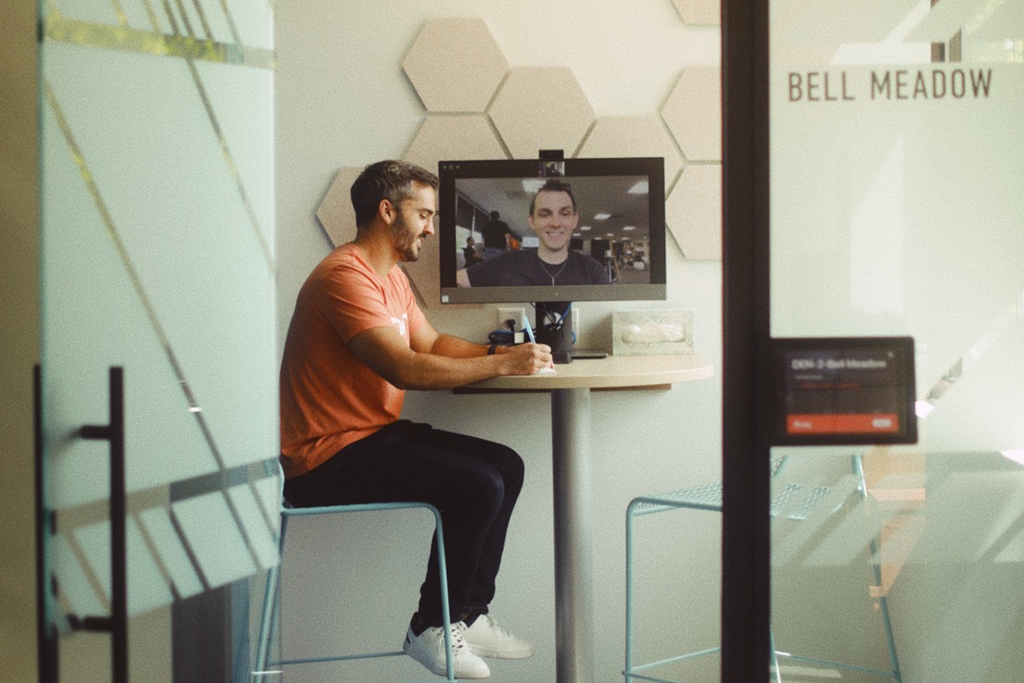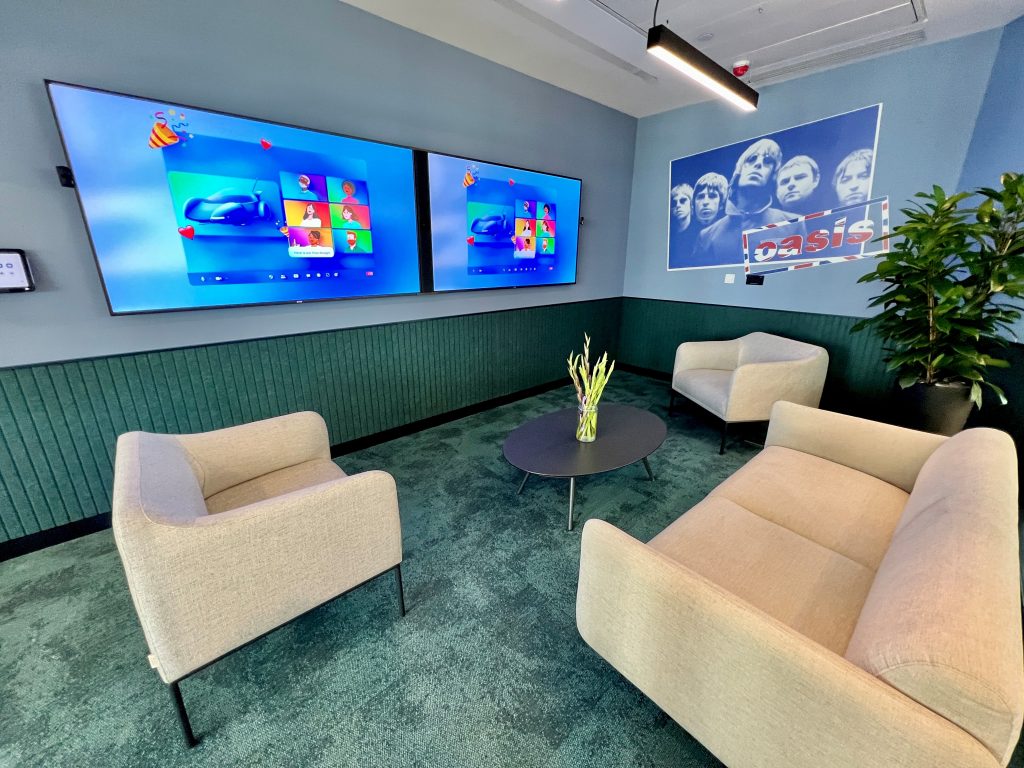
How to build your best hybrid work environment with Zoom
See how innovations like smart name tags and intelligent director for Zoom Rooms help address three common challenges in your hybrid work environment.
Updated on February 01, 2025
Published on August 09, 2023


Whether your employees are in the office a few times a week, 100% remote, or connecting across multiple locations, it’s time to update your hybrid workplace technology to support your team’s needs, wherever they’re working.
Hybrid work technology refers to all the software tools and hardware devices in your workplace that help in-person and remote work employees collaborate with each other. And with teamwork more dispersed than ever, facilities and workplace departments need to design and outfit their spaces with hybrid work tech that supports distributed teams.
A 2022 Gallup poll shows that hybrid work has increased steadily since 2020 to a high of 49% in June 2022, and 8 in 10 remote-capable employees are on a hybrid schedule or work remotely full time. Employees are often collaborating with a mix of colleagues who are in person or remote, but according to Zoom’s head of real estate and workplace, Alana Collins, most offices are not properly equipped for effective hybrid work.
“From my experience in talking to several of our industry peers, companies are still navigating this new hybrid work era,” Alana said. “Conference room technology is outdated and there aren’t enough collaboration spaces that can be used equally for in-person or hybrid gatherings.”
Evolving your hybrid workplace technology helps people connect better and be more productive, no matter where they’re located. Here are some tips for setting up a hybrid work environment for a better employee experience that also makes more efficient use of space.
If your employees are working from home several days a week, not everyone is going to need their own assigned desk at the office. But how can you make sure employees who come into the office have space to work?
Office hoteling, or reserving a desk in the office for when you come in, has become a common approach for companies with a hybrid work model. Think of it as an evolved form of hot-desking, which involves choosing desks on a first-come-first-served basis.
With hot-desking, employees who show up to the office might not be able to find a workspace next to their team members or with the setup they prefer. Worse, they may not be able to find a desk at all.
Hoteling lets employees book their workspace ahead of time, ensuring everyone has a space for the day and the tools they need to be productive and plan ahead.
Desk booking software like Zoom Workspace Reservation allows employees to pick a desk near their project team for better collaboration or find a spot near the coffee machine if they prefer. Your solution may even use AI to recommend the best seat based on an employee’s preferences or next to frequent collaborators.
Hoteling isn’t just handy for employees — facilities teams will be able to see how many people are coming into the office based on workspace reservation data. “For our team, analytics are really important to learn how we can continue to invest in those areas people spend the most time in, or experiment with underutilized spaces,” Alana said.
That could inform some of your decisions. Maybe you can consolidate office space from several floors down to one, or even close a satellite office that’s no longer needed. Plus, office managers can plan more efficiently for lunch orders, supplies, and other in-office items.
Having a place to sit is just part of the equation. Working alongside direct team members allows employees to quickly ask each other questions, chat about related projects, and build a sense of community — all important parts of the in-office experience.
Setting up workplace “neighborhoods” within your office for different departments can help employees find seats close to those they work with most. This approach allows you to allocate the appropriate space that each department needs — for instance, if most of your product team is in person, you might want to place their neighborhood on a floor that has larger conference rooms to support their team meetings. If your finance team is largely remote, you can allocate fewer desks and set up a smaller neighborhood.
You can designate neighborhoods within your desk booking system so employees know where to look when reserving their desks.
Employees who have a flexible or hybrid work schedule might feel more motivated to go into the office if there are a variety of spaces that meet their needs for hybrid meetings, focus work, and socialization. When designing these spaces, from individual workstations to meeting areas, take into account what employees are looking for out of various environments and experiences.
“As workplace leaders, we need to ask ourselves, ‘Do we have the right technology and resources available to employees to help them have the best work day when they’re in the office?’” Alana said.
Alana noted that Zoom’s new London office includes 75 work points, ranging from library-style benches, touchdown spaces, and agile tables for collaboration to traditional desks. “Our employees can book these spaces with our Workspace Reservation tool, helping them plan and navigate their day in the office,” she said.
Here are a few different types of spaces your office might need:
One-person, phone booth-style spaces are perfect for employees to have a private spot to take a video call without bothering people at their desks.
Employees may want meeting areas that are smaller and less formal than conference rooms for team meetings. Set those spaces up with an all-in-one device for video conferencing — perfect for two to three people to meet comfortably with remote colleagues.

Larger rooms can be set up as hybrid gathering spaces for all-hands or town halls where in-person and remote workers can come together. Optimize these types of spaces for presentations, keeping in mind that you may have presenters both in the office and on Zoom.
Employees who come into the office may want space to socialize or have impromptu conversations. Consider how your communal areas might facilitate ad hoc meetups and informal meetings.
When you need to quickly set up a hybrid meeting space on the fly, an all-in-one meeting device on a mobile cart can be a great option. You can simply wheel it to a room to set up a video meeting in a snap.
Employees may want meeting areas that are smaller and less formal than conference rooms for team meetings. Set those spaces up with an all-in-one device for video conferencing — perfect for two to three people to meet comfortably with remote colleagues.
Conference rooms are an office staple, but most are set up for in-person collaboration around a long, large table. When you add remote participants into the mix, they get the dreaded “bowling alley” view, where it’s almost impossible to clearly see or hear people at the far end of the table. In-person participants end up talking mainly to each other while remote attendees find it hard to engage with the conversation.
Now that so many of us work with dispersed teams and meet with customers or partners remotely, it’s time to optimize your conference room with hybrid workplace technology:
When making decisions about your physical offices, you might think fully remote employees are unaffected — after all, they may never step foot in your workspace. However, your hybrid workplace technology has a direct effect on how in-person employees interact with their remote colleagues.
Some of the solutions mentioned above, like smart cameras and digital whiteboards, allow remote employees to have a more engaging experience, especially in hybrid meetings. When designing different types of spaces, pay attention to lighting, camera angles, audio systems, and other details that matter for remote participants.
“We’re seeing how our workspaces can encourage in-person collaboration and innovation while also having the tools and technologies to foster digital connection and a sense of community with our global teams,” Alana said.

As employees rely on hybrid work technology and effective workspaces to get things done, the relationship between a company’s IT and workplace teams is more important than ever.
Workplace or facilities teams should work hand in hand with IT to optimize the complex relationship between people, the places they work, and the technology they use. This means gaining an understanding of what employees need (through surveys, interviews, and other feedback initiatives), and working together to create spaces that seamlessly incorporate digital collaboration tools.
You may find that your office has too many large meeting rooms that employees just aren’t using, or too many open workstations when employees are looking for private booths. Surveying employees on a regular basis and understanding how they’re using your current spaces can help you stay informed and make decisions about your office design.
Want more ideas for setting up your office with hybrid workplace technology? Check out our webinar on modernizing your workplace for hybrid teams.